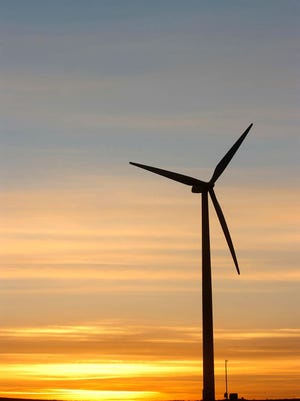OC offshore meteorological tower step toward wind farm

The path toward a wind farm off the coast of Ocean City is nearing reality, as a permit to construct a meteorological tower received no public opposition.
The tower, proposed by Baltimore-based US Wind, is a 328-foot above sea level structure resting on a 60-foot above sea level platform.
Construction plans are set to begin in 2017 and remain operational until 2044. While the tower will run on solar powered batteries — creating no emissions — a meeting to discuss emission concerns regarding the number of gasoline or diesel powered boats and construction equipment prompted a public meeting Tuesday, Feb. 28, at Stephen Decatur Middle School.
Despite a modest turnout of citizens, no members of the audience expressed an objected to the plan.
"I think this is a good sign that we're doing something right," said Paul Rich, director of project development for US Wind. "We've made a real concentrated effort to reach out to citizens and educate them on what to expect.
Offshore wind farms near reality for Delmarva
The offshore wind farm proposed by US Wind would be the second in America, following the five-turbine project 3 miles off the coast of Block Island, Rhode Island, completed by Deepwater Wind and launched in December 2016.
The ultimate goal of a 750-megawatt farm off Ocean City, with turbines rated at either 4 or 6 megawatts, would dwarf the Block Island's 30-megawatt farm, said Rich, who worked on the Rhode Island project, too.
This would account for approximately 7.5 percent of the total Maryland grid usage, he said.
"What this could do is lower the reliance on places like the Indian River plant," Rich said.
The quest for offshore wind in Maryland came following the passage of House Bill 226, or the Maryland Offshore Wind Energy Act. The bill, which opened up the floor for applications to build between 10 and 30 miles off the coast, brought with it a scramble to seek approval to build.
US Wind is not the only company that has applied for a farm off the Delmarva coast.
Deepwater is also in the running to build a wind farm off the coastline, further north in a plot about 17 miles northeast of the Ocean City coastline.
But there are differences. Deepwater is not planning on constructing a meteorological tower at their site — instead opting for a new technology known as Lidar, said Clint Plummer, vice president of development for Deepwater.
"METs (towers) are really old technology and not really needed," Plummer said. "Most of the European offshore wind farms have already switched to Lidar, and that's the route we plan on going. It's a more efficient and less intrusive method of getting our wind measurements."
Maryland reviewing proposals for offshore windmills
Though Deepwater is planning to submit an application to deploy the Lidar systems, the exact date has not yet been decided, Plummer said.
"We will be discussing it sometime in the future, but right now, we haven't applied for the permit," Plummer said.
The ultimate purpose of Lidar and meteorological towers is to understand the wind characteristics off the coastline, and thus, what types of turbines need to be constructed.

"This is an important step in understanding the logistics of the project," Rich said. "This will really help us understand the scale of the wind out at sea."
The project, as well as being a way to bring more clean energy to Maryland, brings a myriad of economic benefits for residents of the Eastern Shore.
"When a project like this comes along, and proves that is feasible, this can only prove positive for the Eastern Shore," said Mike Drew, a manufacturing engineer and Salisbury resident.
READ MORE: Maryland House overrides Hogan in favor of wind, solar
Drew, specifically, cited the possibilities for construction of turbine blades, as well as upkeep on the farm, as benefits of the project.
"What this means for the Eastern Shore is not just a stable source of renewable energy," Drew said. "It means an important economic development, and an opportunity for a lot of good manufacturing and maintenance jobs."
Both manufacturing and construction jobs on the Eastern Shore have seen a decline in the past 11 years. Wicomico County, for example, saw an employment rate in manufacturing of 10.2 percent, and construction at 7 percent in 2004, according to the University of Maryland. In 2015, those numbers came in at 7.7 percent and 4.3 percent respectively, according to the Maryland Chamber of Commerce.
For Rich, the future of offshore wind is seen as one that is bright, and filled with opportunity for residents of the Shore.
"I think at the beginning, there was some skepticism, but people are coming around," Rich said. "I had met with a lot of fishermen, for example, and once I explained what the project is, they understood that this is mostly a good thing, and won't hurt their livelihood. And that's a concern people rightfully had, because this is new."
Pending smooth approval of the next stages of the project, Rich speculated the ultimate groundbreaking date for the US Wind farm would take place in 2020.
gfanelli@dmg.gannett.com